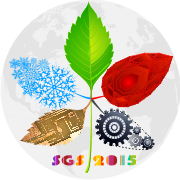 Organized by
Organized by
|
IUTAM Symposium on Growing solids June 23-27, 2015, Moscow, Russia |
|
News:
23-27.06.2015. Symposium in Izmailovo (Gamma-Delta) Hotel Complex 11.06.2015. Proceedia Templates is available 25.05.2015. Symposium Schedule (revision version) is available 15.05.2015. Sightseeing Tours & Banquet details and prices 01.05.2015. Symposium Schedule is available 10.03.2015. Update Keynote Lectures information 15.02.2015. The extended abstracts submission deadline has been extended to March 31, 2015 21.12.2014. Second Announcement (pdf 2.16 MB) 18.11.2014. Extended abstracts templates 24.10.2014. First Announcement (pdf 2.16 MB) 01.10.2014. Symposium Site open About SymposiumA vast majority of objects or solids that surround us arise from some growth processes. As an example, one can present natural phenomena such as the growth of biological tissues, glaciers, blocks of sedimentary and volcanic rocks, and space objects. Similar processes determine the specific features of many technologies in industry, including well-known technologies of crystal growth, laser deposition, solidification of melts, electrolytic formation, pyrolytic deposition, polymerization, and concreting. Recent research has shown that solids formed by growth processes differ in their properties essentially from solids in the traditional view. Moreover, the classical approaches of solid mechanics to modeling the growing solids behavior fail. They should be replaced by new ideas and methods of modern mechanics, mathematics, physics, and engineering sciences. Thus, at present, a new area of solid mechanics is forming, which deals with the construction of adequate models of solid growth processes. The main objectives of the IUTAM Symposium on Growing Solids include a joint discussion of fundamental, computational, and applied problems of the new scientific area by leading mechanicians, mathematicians, physicists, and technologists, exchange of the latest ideas and achievements, as well as working out the main directions of its further development. The symposium program includes topics such as the fundamental problem of solid growth processes, numerical modeling of growth, moving boundaries and interfaces, surface science, phase transitions, dislocations and disclinations in solids, crystal growth, growth of bone and soft tissues, laser deposition, solidification of melts, electrolytic formation, and engineering applications. Aim and ScopeThe main objectives of the IUTAM Symposium on Growing Solids include a joint discussion of fundamental, computational, and applied problems of the new scientific area by leading mechanicians, mathematicians, physicists and technologists, exchange of the latest ideas and achievements, as well as working out the main directions of its further development. The symposium program includes topics such as the fundamental problem of growth processes of solids, numerical modeling of growth, moving boundaries and interfaces, surface science, phase transitions, dislocations and disclinations in solids, crystal growth, growth of bone and soft tissues, laser deposition, solidification of melts, electrolytic formation, and engineering applications. Topics
|
